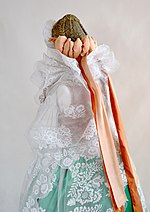Saybuscher Land
The Saybuscher Land (Polish Żywiecczyzna ) is a historical region in Lesser Poland in the West Beskids . It is named after the city of Żywiec (Saybusch) in the Saybuscher basin (Kotlina Żywiecka). In addition to this, the slopes of the Silesian Beskids , the Little Beskids , the Makow Beskids and the entire Saybuscher Beskids also belong to the Saybuscher Land. The most important river in Saybuscher Land is the Soła .
history
In ancient times there was a Celtic fortress on the Grojec hill, which was expanded into a West Slavic fortress in the early Middle Ages. During the Polish particularism around 1177 the still sparsely populated Saybuscher Basin was spun off as part of the Auschwitz castellany from Lesser Poland or the Duchy of Krakow and became part of the Silesian Duchy of Ratibor , although the area always remained in the Diocese of Krakow . In 1315 the Duchy of Auschwitz and Saybusch were spun off from the Duchy of Teschen . Since 1327 the duchy was under feudal rule of the Kingdom of Bohemia . At that time, the area was also partially populated by German settlers (e.g. Rychwałd ). In 1445 Saybusch mentioned the soft picture in the sentence in our Zeywisschem weig picture for the first time. The Weichbild was spun off shortly afterwards from the Duchy of Auschwitz as the Land Saybusch (Polish: Państwo Żywieckie ). The private land existed until 1944 (from 1838 in the possession of the Teschen Habsburgs), administratively with the rest of the Duchy of Auschwitz-Zator in 1569 as the district of Silesia in the Polish-Lithuanian aristocratic republic . The Saybuscher Land thus became the most south-westerly region of Lesser Poland or the Krakow Voivodeship until the First Partition of Poland . In the course of the so-called Wallachian colonization, numerous new shepherd settlements were established in the mountains. The Wallachians made up a significant proportion of the population as early as the second half of the 16th century and spread the lifestyle that is most closely associated with the culture of the Saybuscher country today - the Saybuscher Gorals .
In 1772 it came to the Habsburgs as part of Galicia (in 1780 mitywiec with 2564 was the largest city in the Myslenice district , later the seat of the district of the same name ). After the First World War, the region came back to Poland and the Krakow Voivodeship . From 1975 to 1998, the area belonged to the Province Bielsko-Biala and was therefore colloquially often as part of the landscape Podbeskidzie ( Podbeskidzie considered). It is currently largely part of the Silesian Voivodeship . The eastern smaller part belongs to the Lesser Poland Voivodeship .
Culture
The Saybuscher Land is u. a. inhabited by the Polish Saybuscher Gorals who speak the Lesser Poland - Goral dialect. The townspeople of Żywiec / Saybusch had their own specific costume and dialect.
literature
Prof. Jerzy Kondracki. Geografia fizyczna Polski. Państwowe Wydawnictwo Naukowe. Warszawa. 1988. ISBN 83-01-02323-6



